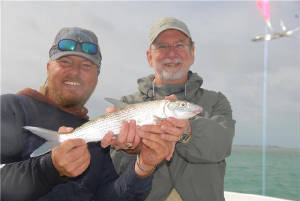|

Bonefish inhabit tropical and warm temperate waters worldwide, Although western Atlantic bonefish are occasionally taken
as far north as North Carolina, New York, and New Brunswick, this species is most plentiful in south Florida, the Bahamas,
and Bermuda. To the south, they range throughout the Caribbean Sea to Brazil. On the eastern Pacific coast, the bonefish occurs
from San Francisco Bay, California, south to Peru and west to Hawaii. Bonefish are
predominately a coastal species, commonly found in intertidal flats, mangrove areas, river mouths, and deeper adjacent waters.
The flats vary in composition from sand or grass to rocky substrates. Bonefish can tolerate the oxygen-poor water they sometimes
encounter in coastal habitats by inhaling air into a lung-like air bladder. Bonefish typically school, sometimes in groups
of up to 100 individuals. Studies in the Bahamas using ultrasonic telemetry demonstrated the daily patterns of bonefish consist
of a movement to shallow water during the rising tide, and a retreat into deeper water during a falling tide. Bonefish are
also known to move from particular sites (creek, channel, bay, etc.) after inhabiting the location for a maximum period of
several days. Over the long-term movements between such "favorite" sites seem to occur without any discernable pattern.
During summer months, larger individuals tend to remain in deep water, rarely moving onto the flats; they reappear in autumn,
as water temperatures grow cooler. In the Caribbean Sea and western Atlantic Ocean, the bonefish reaches a maximum
length of about 31 inches (77 cm) and a weight of 13 or 14 pounds. Floridian and Bahamian fish often range from 4-6 pounds
(1.8-2.7 kg), with fish over 8 pounds (3.6 kg) regarded as large. However, bonefish taken from Africa and Hawaii may attain
weights over 20 pounds (9.1 kg). Bonefish reach sexual maturity between 3 and 4 years of age, at which point they are typically
between 17 and 19 inches (43-48 cm) in length. Bonefish may live in excess of 19 years.
·
The bonefish uses its conical snout to dig through the benthos to root up its prey, which it crushes and grinds
with its powerful pharyngeal teeth. Bonefish feed on benthic and epibenthic prey, often in water less than 30 cm (12 inches)
in depth. In south Florida, the prey consists primarily of crustaceans (xanthid crabs, portunid crabs, alphiid shrimp, penaeid
shrimp), mollusks (clams and snails), polychaete worms, and fishes (primarily the gulf toadfish, Opsanus beta). The gulf toadfish is commonly found in the stomachs of larger bonefishes. Bahamian populations of
bonefish appear to feed more heavily upon bivalves than do Florida Keys bonefish. Bonefish forage primarily on the flats,
entering shallow water on rising tides. While in motion, schooling bonefish travel at the same speed and at a constant distance
from each other. When feeding, the bonefish disperse slightly from the school but will reunite if frightened, again traveling
in a patterned formation. Bonefish do not always travel in schools, but may also be found singly or in pairs. Schools of similar
sized fish may consist of 4-6 individuals, or may number in the tens or hundreds. Large adult specimens are solitary.
In
Florida, the commercial sale of bonefish is prohibited. Bonefish caught by recreational fishers must be larger than 18 inches
(45.7 cm), with a bag limit set at one fish per angler per day. This minimum length is less than the minimum length that the
female must reach to be sexually mature. However, like the tarpon, permit, and other gamefish of the western Atlantic, bonefish
provide the base for a large charter industry in Florida, the Bahamas, and throughout the Caribbean. Thus, most bonefish guides
and anglers esteem the bonefish to such a degree that bonefish are nearly always released unharmed. Most mortality attributed
to human activity occurs from injuries incurred when being landed, such as "gut hooking" or sharks that take advantage
of the hooked fish. Although this is considered an important game fish, the flesh is bony and not highly prized.
|
